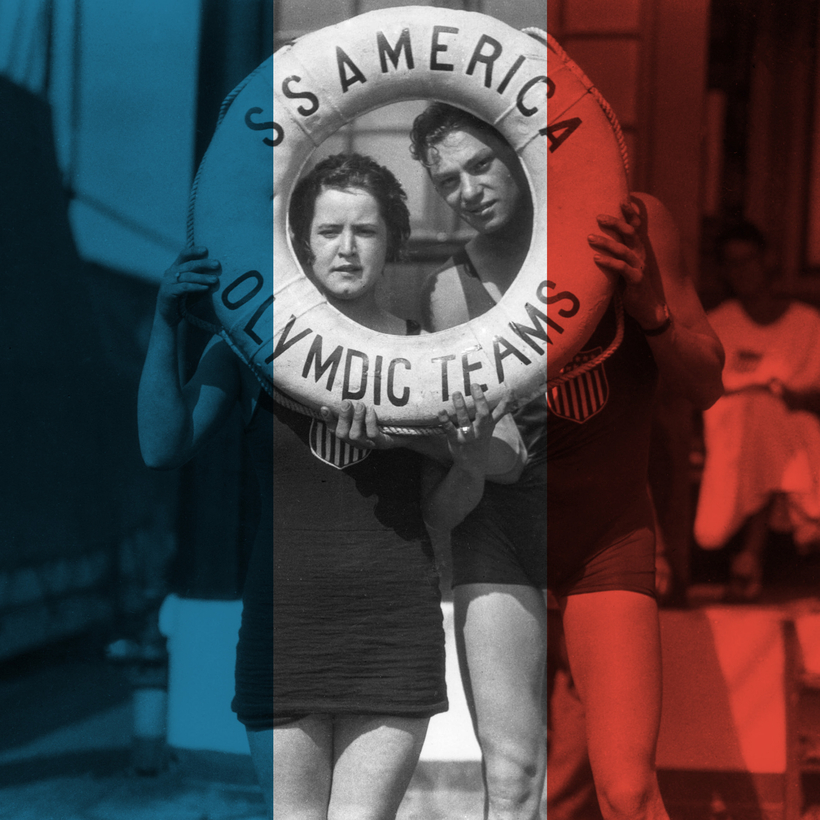To say the Yanks were excited to arrive in Paris for the 1924 Summer Olympics is an understatement. Some 350 of them sailed from New York. They were at sea for more than a week, training on the deck of a ship moving slowly across the Atlantic.
The U.S. Rugby team, forbidden to disembark in Boulogne because of a visa snafu, charged off the ship anyway, scattering the gendarmes. “You watch us!” athlete Norman Cleaveland yelled at them. “See if we get off this boat!”
Later, at the Saint-Lazare train station, John Faricy, a gold-medal hopeful in the breaststroke, leapt from the still-moving train, eyeing a young Frenchwoman hawking baguettes. He stumbled, breaking his ankle. For the rest of his life, Faricy, whose injury kept him out of the Olympic Games, would say the sight of French bread made him ill.

The Paris correspondents for L’Auto and other publications were there to record the American invasion, with most of the ink devoted to swimming captain Duke Kahanamoku and his brother Sam, who serenaded reporters with a quiet and nostalgic song played on their ukuleles. It “filled the air with weird strains of unalloyed jazz and the more subtle Hawaiian melodies,” reported the Paris Times.
Duke looked ageless, gushed the reporters. His teammate Johnny Weissmuller, still many years away from pivoting to Hollywood and starring as Tarzan, was likened in appearance to Maurice Chevalier, the handsome French singer and actor. Weissmuller had lit up when he saw an American car parked on the street. “I traveled 3,000 miles only to see a Ford on the other end,” he said.
About 100 U.S. athletes, including the swimmers, were assigned to spartan wooden huts in the Olympic Village, in the suburb Colombes. “This was decided upon in the interest of goodwill, showing that the United States is not boycotting the official Village,” the Los Angeles Times reported. After a single night, the rowers from Yale—among them James Rockefeller, scion of the oil magnate John D. Rockefeller—packed up and left for the Hôtel Ritz.

Some 200 athletes were housed in wooden barracks erected on Rocquencourt park grounds, which slept two to a room on hard cots. To the annoyance of the veteran athletes, the camp was run military-style. A bugler awoke athletes at 7:30 a.m., and lights-out was at 10:30 p.m. Permission had to be granted to leave the camp, and in case an excursion went awry, the athletes had tags hanging from the lapels of their coats that read, in French, “I desire to go to the Murat estate at Rocquencourt.”
All of the U.S. coaches and officials were on edge about discipline. Rocquencourt was chosen partly because it was far removed—eight miles on torturously bad roads—from Paris’s seductive diversions. “I was greatly surprised to see many of the boys smoking during the trip,” said the swim-team manager, D. L. Conkling. “Drinking was added to smoking as soon as Paris was reached.”
The U.S. team’s biggest rival was the renowned nightlife district of Montmartre, joked Olympic correspondent John O’Brien. Olympic-themed events were scheduled at the clubs from midnight to six a.m., featuring girls in flimsy silk togs racing across dance floors, and swimming contests held in tanks filled with champagne instead of water.
Weissmuller, a gold-medal shoo-in and spirited Chicago wise guy, was a wild card. On the team’s first day in Paris, he heard an anti-American jeer from a passing bicycle rider. He chased after the man, dragging him to the ground and thrashing him. Weissmuller was called before U.S. Olympic Committee officials the next day. He avoided getting sent home only because of his coach’s persuasive defense.
General Douglas MacArthur, who oversaw military members on the U.S. team, wasn’t pleased. Just before they had disembarked the S.S. America, he had sternly reminded everybody aboard, “Now, remember you are ambassadors of the United States, and we expect you to behave accordingly.”

Somehow, the Americans made it without incident to the Opening Ceremony, at Colombes Stadium, on the morning of July 5. A duo of French flyers piloted a biplane, while a floatplane zoomed down into the stadium. It was an ode to the modern-aviation age and the adventurous strivings of the great republic. But when the planes, with “motors crackling like machine guns,” as the Chicago Tribune put it, zoomed by the packed arena, some athletes screamed. The planes came in so fast and so low—at the request of motion-picture cameramen—a fiery crash looked inevitable. The actor Douglas Fairbanks, who was attending the ceremony, held Canadian actress Mary Pickford tightly as the planes seemingly dive-bombed.
The Parade of Nations that followed settled the crowd. Some 3,000 athletes from 45 countries—up from 29 at the 1920 Games—strode in. The United States’ delegation (with 299 athletes, twice as big as any other) stretched out before some 5,000 screaming American fans. The Yanks’ coaches, trainers, and masseuses alone dwarfed the tiniest delegations, such as the two-person China team.
The long ceremony included a mass release of hundreds of carrier pigeons to deliver the news throughout the Continent that the Paris Games were underway. Three 200-piece military orchestras, along with French and Czechoslovakian choirs, launched into the “Marseillaise.”
“Automatically, your hand goes to your hat and you rise to your feet,” wrote Elon Jessup, a correspondent for The Outlook magazine. “Standing at attention, a little shiver runs up and down your spine. How could it be otherwise?”
The ceremony, followed by a historic win of 99 medals for America, would never be forgotten. As one gold medalist put it, “Paris, I can assure you, is one of the best places in the world to be a hero.”
Todd Balf writes for the Los Angeles Times and the New York Times Opinion pages and is the author of several books, most recently Three Kings


